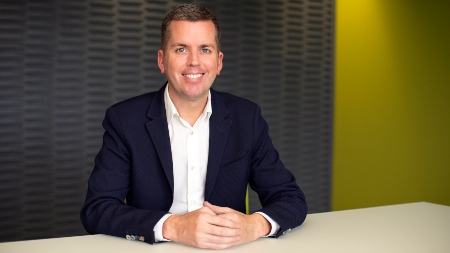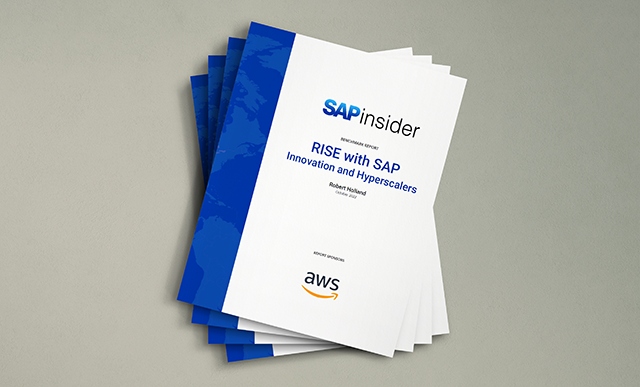Transformation, Imagination, and Innovation
What it Means to SAP's President of Cloud
It’s not often that you hear a technology enthusiast advocating to slow down. However, this mandate comes straight from the source and one of the biggest technology fanatics in the world — SAP’s President of Cloud Brian Duffy. Slow down to speed back up again is what Duffy advertises.
Prior to driving SAP’s latest offering, RISE with SAP, Duffy ran the global company’s EMEA North business. He says working in that part of the world, where he witnessed companies moving to the cloud at a rapid pace, prepared him for his current role. Duffy’s non-traditional path to his current position awarded him with a rich skill set, resulting in a unique leadership approach founded on hearing (vs. just listening) and problem solving. Joining SAP’s legal department as assistant general counsel in 2005 “gave me a broad amount of experience across the company,” Duffy says. “I’ve always been very attuned to getting to the core of a problem by first understanding why the customer sees it as a problem. From there, you have to peel back the onion and understand the root cause before you can develop an effective solution.”
In 2012, Duffy headed up global strategic initiatives where he focused on helping formulate strategic agreements with customers undergoing business transformations and moving to the cloud.
SAPinsider’s Director of Editorial Brianna Shipley sat down with the President of Cloud to learn about his role today, how RISE with SAP is evolving, and Duffy’s opinion on buzzwords like imagination, transformation, and diversity.
Explore related questions

Brian Duffy, President of Cloud, SAP
Q. How has RISE with SAP evolved since its initial launch in January 2021? And how has the response from SAP customers impacted decision-making around this evolution?
To understand the evolution of RISE with SAP you must look at it against the backdrop of how business has changed over the past year.
Historically, the concept of being a technology company was reserved for a few businesses in the market. When 2020 happened, this opportunity expanded significantly and became a survival requirement for nearly every business. The role of IT was elevated tremendously in organizations around the world.
Even companies that were booming with business in 2020 had to make changes because many were delivering products and services they hadn’t provided in previous years. But they had technology systems in place that allowed them to quickly pivot and facilitate monumental change. Ultimately, we’ve seen a huge shift over the past 18 to 24 months, with companies no longer asking why they need to transform but how do we do it.
As of April 2021, SAP has moved 100 SAP customers to RISE with SAP, a number that far exceeded our expectations. What this means is that the concept of holistic business transformation enabled by SAP and SAP partners working in collaboration — the crux of the RISE with SAP offering — is now being actualized. You can read about these customer success stories like Zespri International, the world’s largest marketer of kiwifruit; Atos, a global leader in digital transformation; and Hill-Rom, a global leader in medical technology.
Q. What does it mean to be an intelligent enterprise today?
The need to transform has become fundamental for SAP customers, and in order to transform, businesses need to be an intelligent enterprise. What does that mean? An intelligent enterprise is a business that is supported by intelligent processes. When the end-to-end processes from different departments — from marketing to finance to supply chain — work together, that is considered an intelligent process. And the opportunity that RISE with SAP presents today is to look at disparate processes that the customer is running and create an intelligent process that will fuel organizational transformation.
The world is experiencing a moment in time. Businesses that seize this moment — that slow down and make intentional choices about moving to the cloud — are more likely to see higher return on investment because they’ve taken the time to do it right. The consequences of getting it wrong are severe. There are certain things you can rush through in life, but a move to the cloud is not one of them.
Q. Can you tell me more about the collaborative nature of RISE with SAP? How does the offering help businesses drastically and holistically transform while taking into account the long-term relationships that have likely been established with hyperscalers and SAP partners?
We at SAP are choosing to pull together the best of the ecosystem in service of our customers — something they have been asking for us to do. SAP will work with our customers to understand their needs. Our customers often ask us to weigh in on which hyperscaler is best-suited to serve these needs. SAP has a very deep relationship with all of the hyperscalers (Google, Amazon, Microsoft, and Alibaba). SAP is agnostic and we can work with any of them.
Many of our customers already have deep relationships with existing partners. And if there’s a preference to continue working with those partners, SAP will absolutely embrace that and continue to work with those partners as well. RISE with SAP is a partner-led initiative and at the end of the day, we want to work with a partner that knows our customer as well as we do.
Numerous SAP partners have already launched offerings that directly complement RISE with SAP, making them a key piece of our customers’ transformations. When we can combine forces, that’s when we can truly deliver amazing outcomes for customers and formulate a cloud strategy as opposed to doing a technical lift and shift to the cloud.
Q. What are you most excited about with RISE with SAP and what opportunities do you see it presenting for your customers?
What’s most exciting to me is helping customers re-imagine their business and processes. SAP has been helping customers do this for nearly 50 years. But what’s really exciting about doing it in the present day is that customers are willing to have those conversations with us. The opportunity to re-imagine has always existed but there hasn’t always been the pressure or the necessity to do so. It has been very exciting to actually have people on board to go through that journey and also have the support from leadership.
Even the concept of re-imagining has shifted post-pandemic. I don’t think anyone could have anticipated the many different impacts on every industry caused by a single event. From moving to virtual work and event environments to disruptions to supply chains to shifts in products and services — like automotive manufacturers that used to make cars pivoting to make ventilators — these changes have caused businesses to question everything and determine how to best adapt to change.
One way that SAP is re-imagining is by putting an industry lens on our current offering with RISE with SAP for Industries. SAP has always had a focus on industries, so it makes sense for us to continue to fine-tune and curate the RISE with SAP offering even further in this direction. The package is currently available to five initial industries: automotive, retail, consumer products, industrial machinery and components, and utilities.
This is where companies can standardize while at the same time innovate. It’s going to allow them to operate with the necessary agility, reduce business and technology risks, and ultimately ensure customer satisfaction and deliver on corporate objectives.
Q. Has anything changed from what’s driving customer needs today versus when RISE with SAP first launched earlier this year?
Yes. As businesses start to recover from the pandemic and juggle a hybrid work environment, companies are asking — how are we going to engage with employees? Last year, it was a very different engagement. Now, some employees will be coming back to the office while others may still be working remotely, and many companies are looking at kicking off a people transformation. Organizations see this as a big change and supporting their employees has skyrocketed to the top of their priorities.
SAP’s portfolio includes Qualtrics, which allows us to really understand the sentiment of employees and organizations as a whole. And most recently during SAPPHIRE, we announced the RISE with SAP package for Human Experience Management designed to help customers select various parts of the portfolio that they may need to drive that people agenda.
One of the things that 2020 showed all of us is how fundamental people are to the success of every single organization. None of us — not one organization — can do anything without great people talent. I think the year 2020 shed a light onto that in a huge way.
Q. What does diversity & inclusion (D&I) mean to you, today? Can you talk about how RISE with SAP or SAP’s strategy and mission in general complements D&I?
This is a huge area of focus for me personally as well as being a proud global executive sponsor for D&I within SAP. Within all businesses, it is imperative that diversity be championed in all its shapes and sizes — from gender and ethnicity to age and sexuality — and in the way we embrace diversity of thought, experience, and perspective. This is our competitive edge as an organization. The more diverse our teams are, the more creative and innovative we’ll be for our partners and customers.
What I love about leading our RISE with SAP offering is that it touches all areas of our business. RISE with SAP doesn’t succeed if we don’t maximize cross team collaboration and that in itself requires so many people to come together and bring their diverse talents to the table. RISE with SAP is also about meeting our customers where they are, and on their terms, which in a way is exactly the culture we want to create for our employees too — come as you are, tell us what you want to achieve, and let us work with you to make it happen.
Q. What advice would you give to others who want to become leaders either within SAP or other companies? And how does this advice apply in a digital workforce that has become far more common in 2020 and 2021?
There are a few key points that have shaped my journey as a leader within SAP that I would share with others looking to do the same. First, there is no substitute for hard work. Find what you’re good at and work hard, put your hand up, ask for responsibility and opportunities, and then execute to the best of your ability.
Second, identify people around you who can serve as sponsors for you and your ambition. These people can be mentors as well, but these individuals should be the ones who champion you, your abilities, and your ambitions internally. Everyone needs a sponsor to progress. A sponsor is someone who puts you forward just before you’re ready, who sees your potential and gives you the shot when you are the most hungry to succeed.
Finally, I would say take the time to really understand who you are and what you bring to your work, and then find teams that encourage you to be your authentic self. By identifying your strengths and acknowledging your challenges, you can clearly identify where you can excel and where you need to surround yourself with others that complement you. Leadership is not about being the smartest person in the room; it’s about connecting and orchestrating a diverse set of abilities and perspectives to achieve the greatest value.




